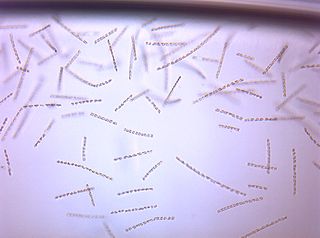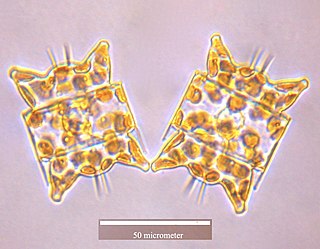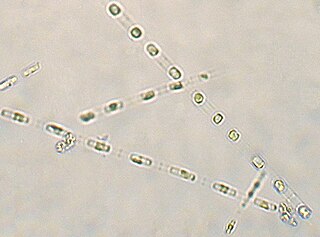Related Research Articles

Chaetoceros is a genus of diatoms in the family Chaetocerotaceae, first described by the German naturalist C. G. Ehrenberg in 1844. Species of this genus are mostly found in marine habitats, but a few species exist in freshwater. It is arguably the common and most diverse genus of marine planktonic diatoms, with over 200 accepted species. It is the type genus of its family.

Members of the genus Metridium, also known as plumose anemones, are sea anemones found mostly in the cooler waters of the northern Pacific and Atlantic oceans. They are characterized by their numerous threadlike tentacles extending from atop a smooth cylindrical column, and can vary from a few centimeters in height up to one meter or more. In larger specimens, the oral disk becomes densely curved and frilly.

Nitzschia is a common pennate marine diatom. In the scientific literature, this genus, named after Christian Ludwig Nitzsch, is sometimes referred to incorrectly as Nitzchia, and it has many species described, which all have a similar morphology. In its current circumscription, Nitzschia is paraphyletic.

Bacillariaceae is a family of diatoms in the phylum Heterokontophyta, the only family in the order Bacillariales. Some species of genera such as Nitzchia are found in halophilic environments; for example, in the seasonally flooded Makgadikgadi Pans in Botswana.

Eupodiscaceae is a diatom family (Bacillariophyceae) present both in marine and freshwater habitats Odontella is the only genera in this family with typical marine species. However, Round et al. (1990) placed Odontella in Triceratiaceae (Schutt) Lemmermann, order Triceratiales Round and Crawford, subclass Biddulphiophycidae Round and Crawford. The taxonomic status of this family is unclear and disputed.

Odontella aurita is a diatom and the type species of genus Odontella. The easiest way to identify this species is by recognizing the very distinct shape of the cells belonging to this genus. Odontella aurita is cultivated industrially for human consumption due to its ability to produce up to 28% of its total lipids as eicosapentaenoic acid (EPA), a long-chain polyunsaturated fatty acid (PUFA). PUFAs such as EPA are known to provide a variety of health benefits in humans, and are commonly obtained by fish oil. However, with the increasing concern of over-exploited fisheries, microalgae are a promising source of PUFAs as they can be grown year-round and their fatty acid profile and content are easily manipulated by growth conditions.

Odontella is a genus of marine diatoms. It contains the following species:
Thalassiosira weissflogii is a species of centric diatoms, a unicellular microalga. It is found in marine environments and also in inland waters in many parts of the world. It is actively studied because it may use C4-plant style strategies to increase its photosynthetic efficiency.

The Cymbellaceae are a diatom family in the order Cymbellales.
Cosmiodiscus is an extinct genus of diatom.

Skeletonema is a genus of diatoms in the family Skeletonemataceae. It is the type genus of its family. The genus Skeletonema was established by R. K. Greville in 1865 for a single species, S. barbadense, found in the Barbados deposit [Jung 2009]. These diatoms are photosynthetic organisms, meaning they obtain carbon dioxide from their surrounding environment and produce oxygen along with other byproducts. Reproduce sexually and asexually [Guiry 2011]. Skeletonema belong to the morphological category referred to as centric diatoms. These are classified by having valves with radial symmetry and the cells lack significant motility [Horner 2002]. Skeletonema are cylindrical shaped with a silica frustule. Cells are joined by long marginal processes to form a filament [Horner 2002]. Their length ranges from 2-61 micrometers, with a diameter ranging from 2-21 micrometers [Hasle 1997]. They are found typically in the neritic zone of the ocean and are highly populous in coastal systems [Jung 2009]. The genus is considered cosmopolitan, showing a wide range of tolerance for salinity and temperature [Hasle 1973]. For example, they have been found in various aquatic environments such as brackish or freshwater. Skeletonema are found worldwide excluding Antarctic waters [Hevia-Orube 2016]. Some harmful effects these diatoms may have on an ecosystem are attributed to large blooming events which may cause hypoxic events in coastal systems. Additionally, they are known to cause water discoloration [Kraberg 2010].

Bacilladnaviridae is a family of single-stranded DNA viruses that primarily infect diatoms.
Hantzschia is a genus of diatoms belonging to the family Bacillariaceae.
Nitzschia granulata is a species of diatom belonging to the family Bacillariaceae.
Hantzschia amphioxys is a species of diatom belonging to the family Bacillariaceae.

Adlafia is a genus of diatoms belonging to the family Anomoeoneidaceae.
Adlafia minuscula is a species of diatoms belonging to the family Anomoeoneidaceae.

Caloneis is a genus of diatoms belonging to the family Naviculaceae.

Ditylum is a genus of diatoms belonging to the family Lithodesmiaceae.

Melosira is a genus of diatoms belonging to the family Melosiraceae.
References
- ↑ Sardet, Christian (2015). Plankton, Wonders of the Drifting World. France: The University of Chicago Press. p. 59. ISBN 978-0-226-18871-3.
- ↑ "Odontella C. Agardh - Wikispecies". species.wikimedia.org. Retrieved 2020-09-27.
- ↑ "WoRMS - World Register of Marine Species - Odontella sinensis (Greville) Grunow, 1884". www.marinespecies.org. Retrieved 2020-09-27.
- ↑ "Odontella sinensis". www.nioz.nl. Retrieved 2020-09-27.
- ↑ "Odontella sinensis (Greville) Grunow | Nordic Microalgae". nordicmicroalgae.org. Retrieved 2020-09-27.
- ↑ "ITIS Standard Report Page: Odontella sinensis". www.itis.gov. Retrieved 2020-09-27.